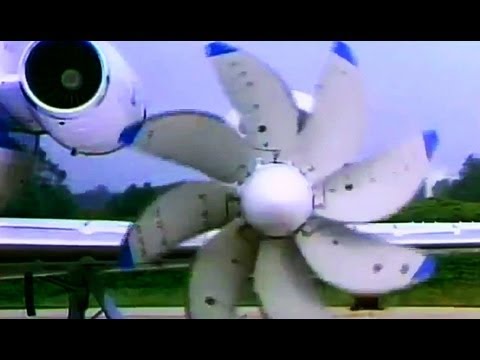Variable Pitch Propfan circa 1981 NASA Lewis Research Center (from “Futurepath”)
more at
“The video presents material concerning Advanced Turboprop programs.”
Public domain film from NASA, slightly cropped to remove uneven edges, with the aspect ratio corrected, and mild video noise reduction applied.
The soundtrack was also processed with volume normalization, noise reduction, clipping reduction, and/or equalization (the resulting sound, though not perfect, is far less noisy than the original).
A turboprop engine is a type of turbine engine which drives an aircraft propeller using a reduction gear.
The gas turbine is designed specifically for this application, with almost all of its output being used to drive the propeller. The engine’s exhaust gases contain little energy compared to a jet engine and play only a minor role in the propulsion of the aircraft.
The propeller is coupled to the turbine through a reduction gear that converts the high RPM, low torque output to low RPM, high torque. The propeller itself is normally a constant speed (variable pitch) type similar to that used with larger reciprocating aircraft engines.
Turboprop engines are generally used on small subsonic aircraft, but some aircraft outfitted with turboprops have cruising speeds in excess of 500 kt (926 km/h, 575 mph). Large military and civil aircraft, such as the Lockheed L-188 Electra and the Tupolev Tu-95, have also used turboprop power. The Airbus A400M is powered by four Europrop TP400 engines, which are the third most powerful turboprop engines ever produced, after the Kuznetsov NK-12 and Progress D-27.
In its simplest form a turboprop consists of an intake, compressor, combustor, turbine, and a propelling nozzle. Air is drawn into the intake and compressed by the compressor. Fuel is then added to the compressed air in the combustor, where the fuel-air mixture then combusts. The hot combustion gases expand through the turbine. Some of the power generated by the turbine is used to drive the compressor. The rest is transmitted through the reduction gearing to the propeller. Further expansion of the gases occurs in the propelling nozzle, where the gases exhaust to atmospheric pressure. The propelling nozzle provides a relatively small proportion of the thrust generated by a turboprop.
Turboprops are very efficient at flight speeds below 725 km/h (450 mph; 390 knots) because the jet velocity of the propeller (and exhaust) is relatively low. Due to the high price of turboprop engines, they are mostly used where high-performance short-takeoff and landing (STOL) capability and efficiency at modest flight speeds are required. The most common application of turboprop engines in civilian aviation is in small commuter aircraft, where their greater reliability than reciprocating engines offsets their higher initial cost. Turboprop airliners now operate at near the same speed as small turbofan-powered aircraft but burn two-thirds of the fuel per passenger. However, compared to a turbojet (which can fly at high altitude for enhanced speed and fuel efficiency) a propeller aircraft has a much lower ceiling. Turboprop-powered aircraft have become popular for bush airplanes such as the Cessna Caravan and Quest Kodiak as jet fuel is easier to obtain in remote areas than is aviation-grade gasoline (avgas)…
A propfan is a type of aircraft engine related in concept to both the turboprop and turbofan, but distinct from both. The engine uses a gas turbine to drive an unshielded propeller like a turboprop, but the propeller itself is designed with a large number of short, highly twisted blades, similar to a turbofan’s bypass compressor. For this reason, the propfan has been variously described as an “unducted fan” or an “ultra-high-bypass (UHB) turbofan”. In technical papers it is described as “a small diameter, highly loaded multiple bladed variable pitch propulsor having swept blades with thin advanced airfoil sections, integrated with a nacelle contoured to retard the airflow through the blades thereby reducing compressibility losses and designed to operate with a turbine engine and using a single stage reduction gear resulting in high performance.” The design is intended to offer the speed and performance of a turbofan, with the fuel economy of a turboprop. The propfan concept was first revealed by Carl Rohrbach and Bruce Metzger of the Hamilton Standard Division of United Technologies in 1975 and was patented by Robert Cornell and Carl Rohrbach of Hamilton Standard in 1979. Later work by General Electric on similar propulsors was done under the name unducted fan, which was a modified turbofan engine, with the fan placed outside the engine nacelle on the same axis as the compressor blades…

